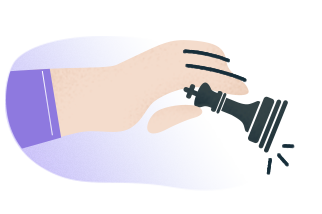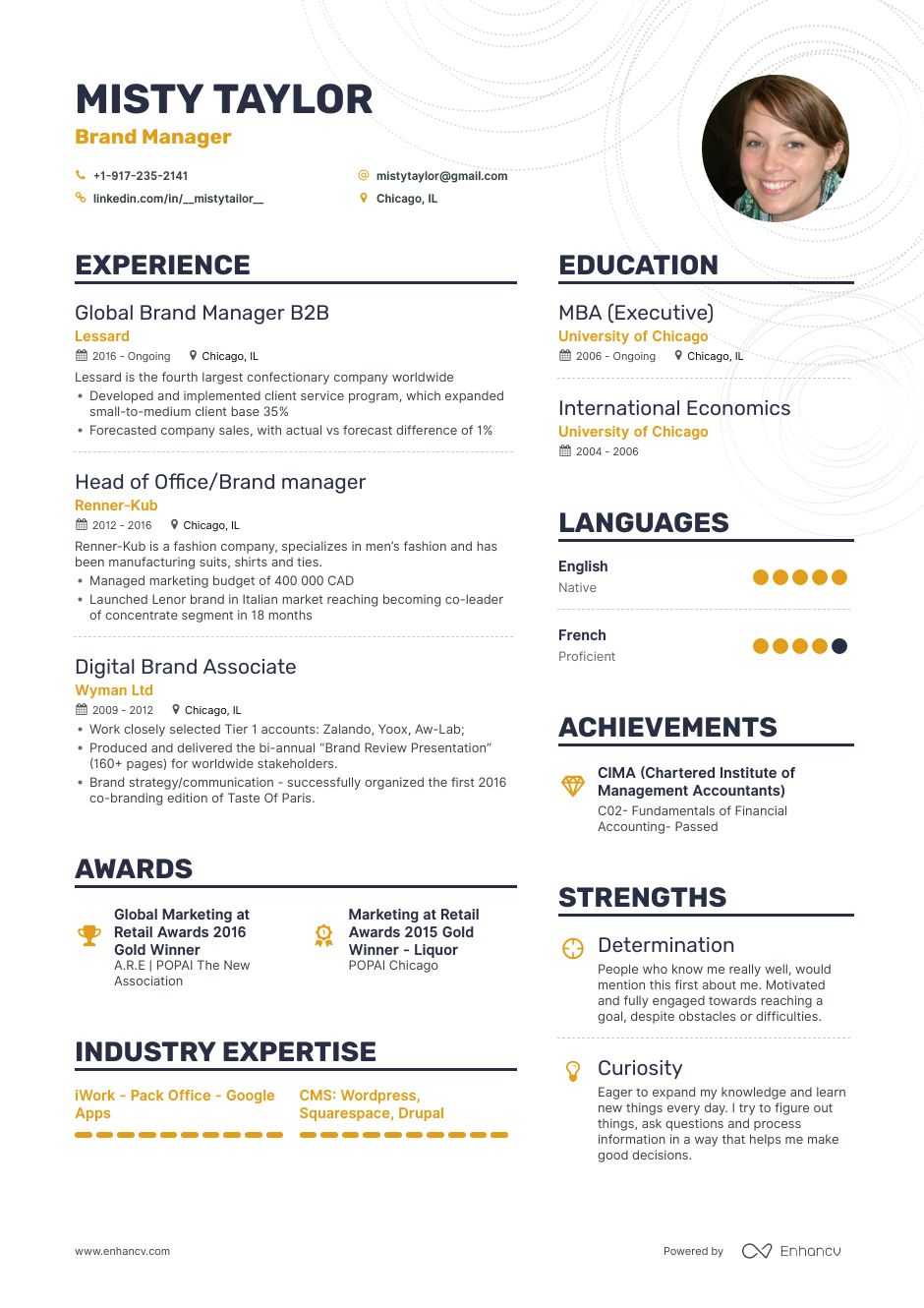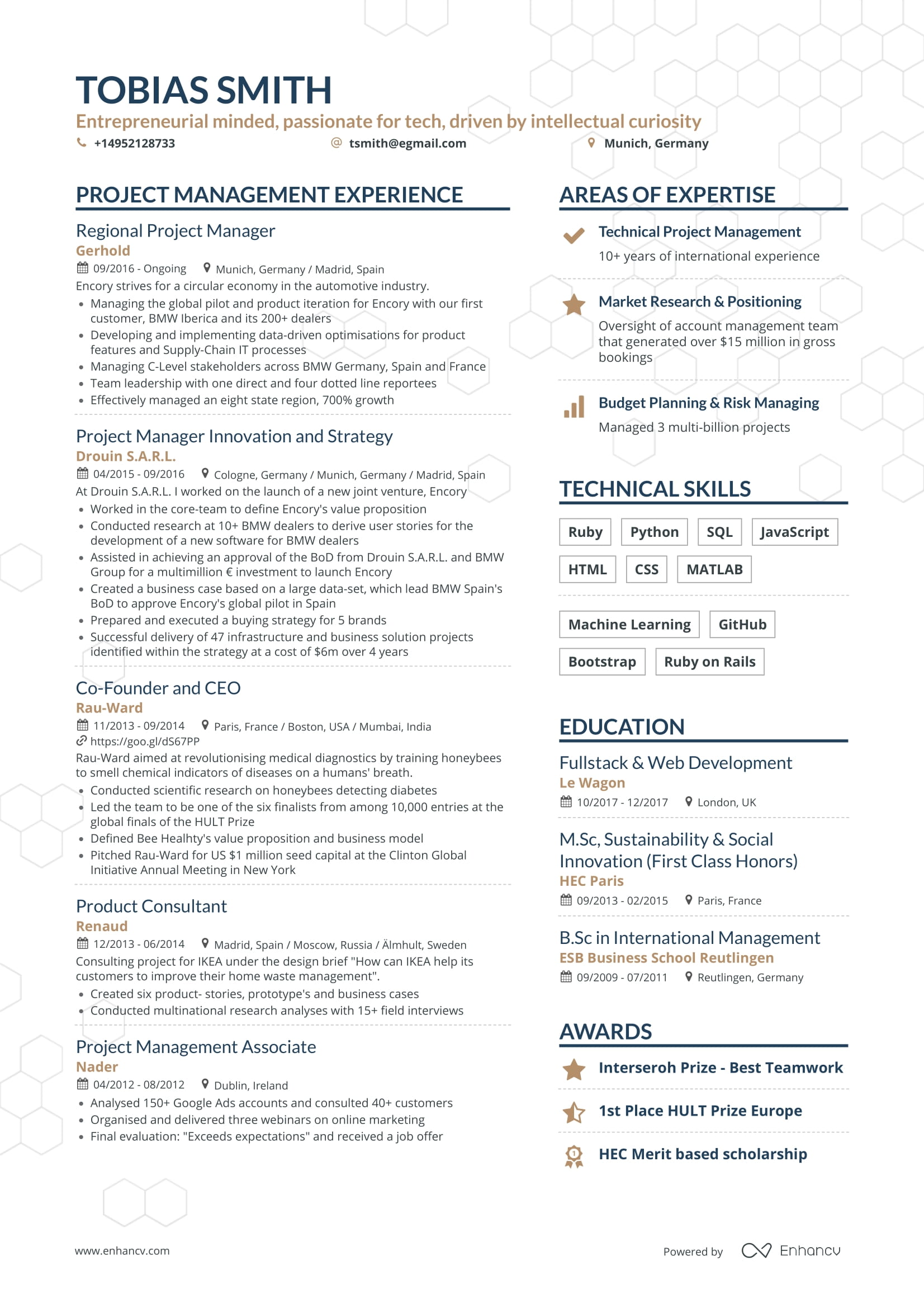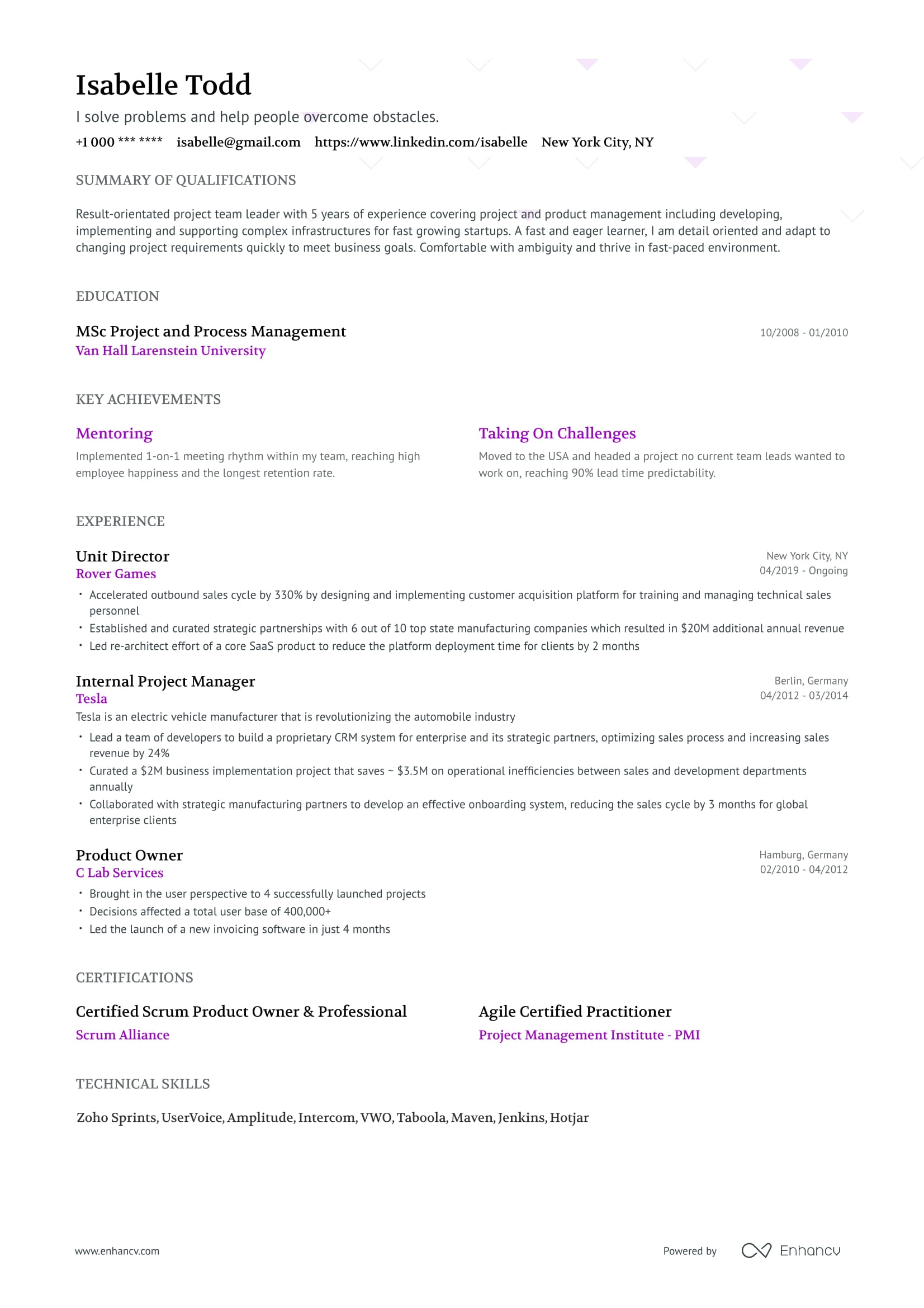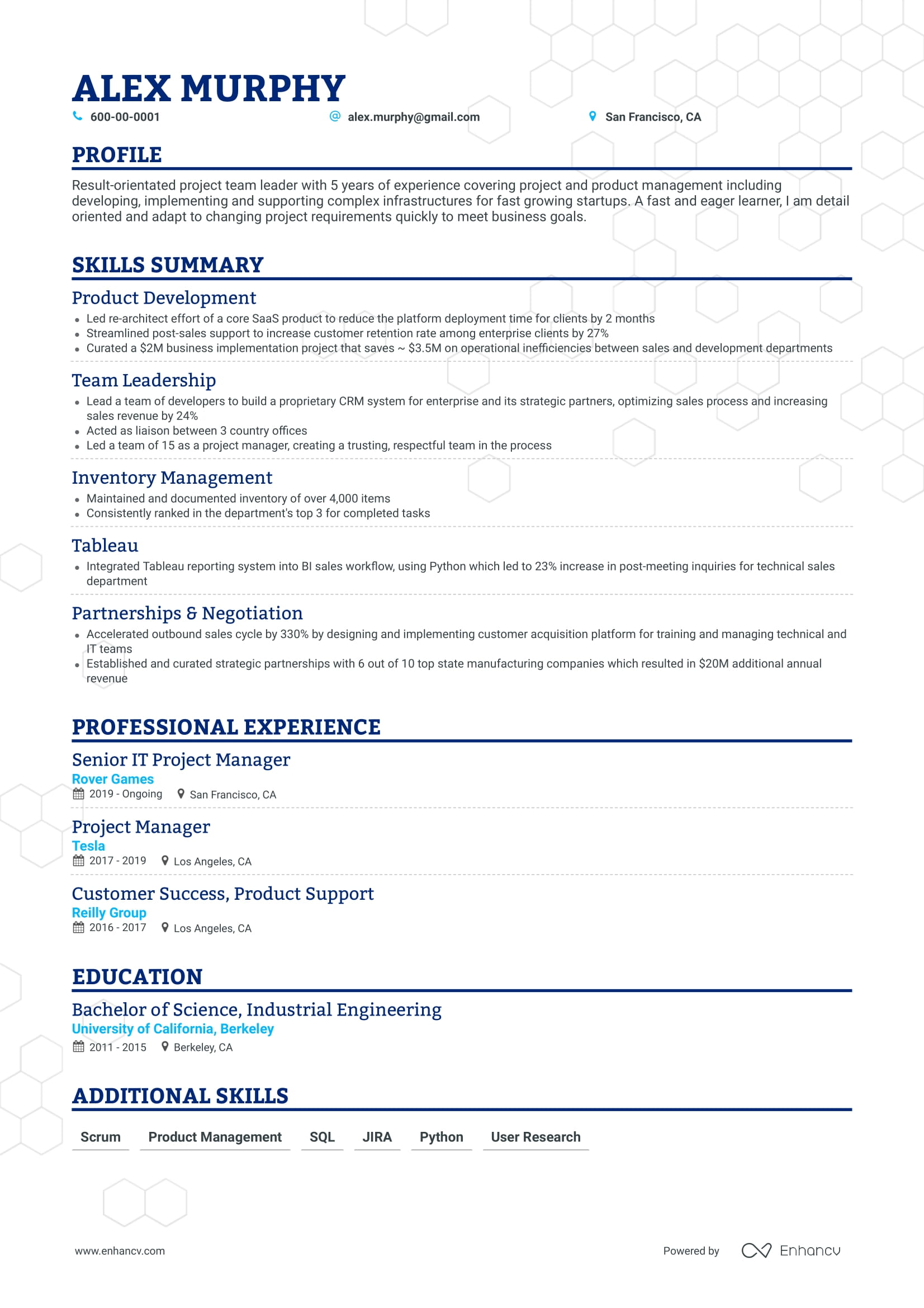Example Brand manager Resume - Browse more resume templates and build a stand-out resume
So, you're applying for Brand Manager jobs. That's great!
You know how hard it can be to land an interview though so you want a way to stand out.
What's the best way to do that? With a brand manager resume that highlights your ability to bring a brand to life.
A Brand Manager can't expect to get a job—or an interview for that matter—with a generic, run-of-the-mill resume.
They need a resume that clearly conveys their experience in defining and driving a brand. A resume that shows their ability to tell a story—not just sell a product.
If you want to land your dream job, we're here to help.
Here’s what you’ll learn today
- 9 Brand manager resume examples showing you the way to create a captivating resume
- 6 sections you cannot miss out on in your resume
- What recruiters want to see in a Brand Manager resume
- Tips for creating a professional and practical resume header
- How to make your skills and software experience stand out
- What experience you should—and shouldn't—include on your resume
- Common mistakes other Brand Managers like you make in a resume and how to fix them
Brand Manager resume sample
Looking for related resumes?
- Brand Ambassador resume examples
- Marketing resume examples
- Social Media Manager resume examples
- Digital Marketing Manager resume
- Marketing Manager resume
- Marketing Director resume
How to write a Brand Manager resume
Brand Managers are creative to their very core, and your resume should reflect that. Don't use any old template you find on the web.
A recruiter spends an average of 6 seconds reviewing a resume.
And you only get one chance to make a good first impression.
Don't make the mistake of using a generic format. Use your branding knowledge to design something spectacular.
And whatever you do, don't use vague statements that undercut your achievements. Be specific about the brand strategies you've created and the value they added.
- How did you position your brand?
- What products did you develop?
- What promotion plan did you put together?
- How did you determine pricing?
Wouldn’t it be great if you were able to answer all of that in your resume in just a few smartly positioned bullet points?
Moving further on, recruiters would be happy to read how you engaged with marketing agencies. Double on the types of cross-functional, complex brand identity projects you worked on
Bonus points if you mention your experience in building a brand from the ground up.
And more importantly, how did your efforts impact sales and overall brand awareness?
Experience matters, but measurable results are what land you your dream job.
Recruiters want to see real, tangible results, not universal statements. Avoid listing your experience as a bulleted explanation of your job description.
Focus instead on your achievements as a Brand Manager.
And be sure to include the proper resume sections. Leaving important pieces out can cause a recruiter to think you're unqualified.
What are the top Brand Manager resume sections?
- Header section with clickable contact information and link to online portfolio
- Summary section with brand management achievements and accomplishments
- Experience section that highlights results rather than just job descriptions
- Skills section that lists industry-standard software and tools
- Education section
- Certification section (optional)
Now that you know the top resume sections, it's time to focus on what a recruiter wants to see in a Brand Manager's resume.
What a recruiter wants to see in a Brand Manager resume
- What experience you have with brand positioning and development
- Real results that highlight your achievements and accomplishments
- How you uncover consumer insights and align marketing campaigns and messaging accordingly
- What types of teams you've worked with; marketing, design, agency, etc.
- How your branding strategy successfully communicated a company's mission and vision
- An ability to think both creatively and analytically
Ultimately, a recruiter wants to know the value you bring. With this and a professional resume header, you'll be on your way to interviewing in no time.
How to create a professional Brand Manager resume header
The header section of a resume might seem simple, but there's actually a right and a wrong way to create one. Include the wrong info and it might never get a second look.
A header should include your name, contact information, and a link to your portfolio. Your name should be the biggest thing on your resume. And you should always hyperlink your email, phone number, and website.
And while we don't want to be Captain Obvious, your email shouldn't be the one you created when you were 12. It should be professional and as close to your name as possible.
Including the correct information and presenting it professionally is key.
2 Brand Manager resume header examples
After finishing the header, it's time to craft a compelling resume summary.
What goes in the perfect Brand Manager resume summary
The biggest mistake people make when writing their resume summary is being too vague. Your summary should be so specific to you that no one else could use it.
2 Brand Manager resume summary samples
Almost any Brand Manager could use this summary. And chances are, it won’t stand out to recruiters.
Here, the summary is much more specific. It lists how many years of experience the candidate has. It gives specifics about the industry they've worked in. And it gives a glimpse into the ways they've successfully managed a brand.
Now, you can expand further in the experience section.
What should my Brand Manager resume experience section feature
The experience section of a Brand Manager resume is perhaps the most important of all. It's your chance to set yourself apart from other candidates.
Whatever you do, don't simply list your job responsibilities. Recruiters know what a Brand Manager does.
They don't want to read your job description. They want to know what value you brought to previous positions. Here are a few things to consider including:
- Specific branding projects you spearheaded and the results of those projects
- The capacity in which you worked with internal marketing and creative teams
- What campaigns you've launched and the results and scale of those campaigns
- Any experience with market research, creative briefing, design, messaging, media, and measurement
You should always tweak your experience section based on the job you're applying to. Read through the job description and then edit as needed.
2 Brand Manager resume experience examples
Unfortunately, a recruiter will be clueless when they read a bland resume experience like this one. It leaves more open questions than it answers:
- What was the product of your collaboration with other teams?
- What were the type of campaigns you launched?
- Did you measure the results?
Let’s improve it below.
Now, that’s the kind of experience a recruiter will trust and give a callback to. It prominently features numbers and results that prove the candidate’s value.
Once you've finalized your experience section, it's time to make your skills stand out.
How to make your Brand Manager resume skills stand out
Brand Managers play an incredibly important part of a company's success. While hard skills are most important to recruiters, you shouldn't overlook soft skills.
What's the difference? Hard skills refer to industry-specific, technical skills that help you succeed.
How to feature technical resume skills
Applying to a kick-ass marketing company?
It’s highly likely your resume will be picked up on by ATS (applicant tracking systems).
They skim all incoming resumes for certain keywords and skills the recruiter wants present in candidates’ documents.
So, make sure you’ve got them featured clearly in your resume.
8 Important tech skills for your Brand Manager resume
- Brand Strategy
- Product Development
- Campaign Management
- Project Management
- Copywriting
- Adobe Creative Cloud
- Campaign Reporting
- Data Analyzation
How to feature soft skills on your resume
Soft skills refer to interpersonal skills.
Soft skills can include things like empathy, adaptability, and conflict resolution. It's best to include soft skills with a real-life example of a time you've used them.
What soft skills recruiters want in Brand Manager resumes
- Creativity
- Adaptability
- Collaboration
- Excellent Written and Verbal Communication
- Positivity
- Empathy
- Problem-Solving
- Reliability
Once your skill section is in order, move on to the education section.
How to feature my education on the resume?
How you feature your education depends on your experience level.
For anyone mid- to senior-level, simply list your degree, major, and graduation year. If you graduated with a GPA above 3.5, include that too.
Recruiters are going to care more about the real-world experience you have. Focus on that rather than going too in-depth about a degree you graduated with years ago.
For entry-level Brand Managers, your education section should be more extensive. Include any relevant coursework, class projects, and related clubs or organizations.
If you have any industry certifications, you can include a separate section for those.
Does my resume need a certification section?
Certifications can be a helpful way to set yourself apart from other candidates. But for Brand Managers specifically, there are no standard certifications recruiters look for.
Here are some that are worth adding.
Top 3 Brand Manager resume certificates
So, now that you've learned about each resume section, we want to review the most important tips and tricks.
Summing up: what are the best tricks when writing a Brand Manager resume
- Include a header section with clickable contact information and a link to your portfolio
- Write a summary that's specific to you and your experience
- Bullet your achievements and accomplishments rather than your job descriptions
- Avoid vagueness; tweak your resume for each job you're applying to
- Design something spectacular; your resume is a reflection of your own personal brand
